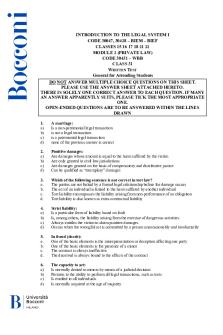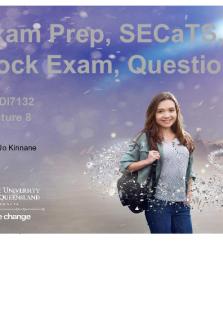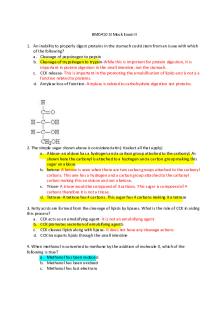BMD410 SI Mock Exam 2 - Mock Exam for Exam 2 covering lectures 9-17 (Carbs and lipids, digestion and PDF

| Title | BMD410 SI Mock Exam 2 - Mock Exam for Exam 2 covering lectures 9-17 (Carbs and lipids, digestion and |
|---|---|
| Author | Gabrielle Lynch |
| Course | Clin Biochemistry For Hp |
| Institution | University of Alabama at Birmingham |
| Pages | 13 |
| File Size | 538.4 KB |
| File Type | |
| Total Downloads | 57 |
| Total Views | 151 |
Summary
Mock Exam for Exam 2 covering lectures 9-17
(Carbs and lipids, digestion and metabolism, glycolysis, gluconeogenesis, citric acid cycle, oxidative phosphorylation, electron transport chain)...
Description
BMD410 SI Mock Exam II 1. An inability to properly digest proteins in the stomach could stem from an issue with which of the following? a. Cleavage of pepsinogen to pepsin b. Cleavage of trypsinogen to trypsin-While this is important for protein digestion, it is important in protein digestion in the small intestine, not the stomach. c. CCK release- This is important in the promoting the emulsification of lipids and is not a a function related to proteins. d. Amylase loss of function- Amylase is related to carbohydrate digestion not proteins.
2. The simple sugar shown above is considered a(n): (select all that apply) a. Aldose- an aldose has a hydrogen and a carbon group attached to the carbonyl. As shown here the carbonyl is attached to a hydrogen and a carbon group making this sugar an aldose. b. ketose- A ketose is seen when there are two carbon groups attached to the carbonyl carbons. This one has a hydrogen and a carbon group attached to the carbonyl carbon making this an aldose and not a ketose. c. Triose- A triose would be composed of 3 carbons. This sugar is composed of 4 carbons therefore it is not a triose. d. Tetrose- A tetrose has 4 carbons. This sugar has 4 carbons making it a tetrose 3. Fatty acids are formed from the cleavage of lipids by lipases. What is the role of CCK in aiding this process? a. CCK acts as an emulsifying agent- it is not an emulsifying agent b. CCK promotes secretion of emulsifying agents c. CCK cleaves lipids along with lipase- it does not have any cleavage actions d. CCK transports lipids through the small intestine 4. When methanol is converted to methane by the addition of molecule X, which of the following is true? a. Methanol has been reduced b. Methanol has been oxidized c. Methanol has lost electrons
d. Molecule X is an oxidizing agent e. Molecule X has a more positive reduction potential that methanol f. Molecule X has a more negative (or less positive) reduction potential that methanol
Remember that molecules with many hydrocarbon bonds (like triglycerides or CH4) tend to be more reduced than molecules with many carbonyl, carboxyl, or alcohol constituencies (like Glucose or CH3OH). When methanol is turned into methane, it is reduced by a reducing agent. Electrons flow to a more positive reduction potential, so Molecule X has a lower reduction potential than Methanol.
5. Excess citrate will have what effect on glycolysis and gluconeogenesis? a. Promotion of glycolysis, inhibition of gluconeogenesis b. Promotion of gluconeogenesis, inhibition of glycolysis c. Promotion of both glycolysis and gluconeogenesis d. Inhibition of both glycolysis and gluconeogenesis B. The citric acid cycle, which has citrate as an intermediate, is downstream of glycogenolysis and glycolysis. So, if there is enough citrate, glycogenolysis and glycolysis need to stop making more. Excess citrate will inhibit glycogenolysis and glycolysis. Gluconeogenesis goes in the opposite direction of glycolysis (from pyruvate to glucose), so it will be promoted. Glycogen synthesis will also be promoted.
6. Which of the following is NOT a function of carbohydrates? a. Energy storage b. Long term energy source for ATP- Lipids serve as the long term energy molecule while carbohydrates are good for quick energy needs. Remember Dr.Wrights analogy of carbohydrates being the money in his wallet while lipids are the money in the bank. c. Structural component of cell walls and exoskeletons d. Informational molecules in cell-cell signaling e. All of the above at functions of carbohydrates
7. These isomers are considered to be… a. Enantiomers-are non-superimposable mirror images. These are not because they differ at at least one carbon. b. epimers- differ at only one carbon c. anomers- formed upon ring closures and these are straight chain. d. both b and c Anomers can also refer to the L and D forms of the same sugar.
8. Which of these is a non-reducing sugar?
a. fructose b. glucose c. sucrose d. maltose Here is what to remember: All monosaccharides are reducing sugars Most disaccharides are reducing sugars (the only exception here is sucrose) All polysaccharides are reducing sugars (when depolymerized)
9. Triglyceride molecules are composed of… a. three glycerol molecules, fatty acid backbone, linked by a phosphodiester bond b. three glycerol molecules, fatty acid backbone, linked by an ester bond c. three fatty acid molecules, glycerol backbone, linked by a phosphodiester bond d. three fatty acid molecules, glycerol backbone, linked by an ester bond 10. Proteins are digested in what portions of the GI tract? (select all that apply) a. Oral cavity b. Esophagus- this is a trick answer; the esophagus is ONLY used for transport and plays no role in digestion. c. Stomach d. Small Intestine e. Pancreas
11. A reaction has a positive delta G naught prime: A + B C. What can make the reaction favorable, given that the following are all possible? (select all that apply) a. Increase levels of A by anaplerotic reactions- this would “push” the reaction forward b. Increase consumption of B by other reactions- this would pull the reaction in the wrong way and cause delta G prime naught to be more positive and more unfavorable. c. Couple with the hydrolysis of ATP- this would “pull” the reaction forward. d. Decrease levels of A by anaplerotic reactions- same as B e. Increase consumption of C by other reactions -this would “pull” the reaction forward. A, C and E. Answer choice A would “push” the reaction forward. B and D would “pull” the reactions towards the reactants. C would power the reaction. E would “pull” the reaction towards the products. 12. Which of the following is NOT a reason that ATP’s hydrolysis has a relatively high negative delta G? a. Orthophosphate (Pi) has more resonance stability than the phosphates in ATP
b. Increased entropy c. Stabilization via Hydration d. Electrostatic repulsion/ negative charges repel each other because they are in close proximity. e. It has high phosphoryl-transfer potential f. all of these are reasons why ATP’s hydrolysis is favorable g. none of these are reasons why ATP’s hydrolysis is favorable 13. Creatine kinase catalyzes the following reaction: Creatine + ATP < ---- > Creatine-P + ADP. What type of phosphorylation is this? a. Photophosphorylation-in plants b. Oxidative Phosphorylation c. Substrate-level Phosphorylation d. Phosphatase- an enzyme 14. What are the regulatory enzymes involved in glycolysis? a. Hexokinase, phosphofructokinase, aldolase b. Hexokinase, phosphofructokinase, pyruvate kinase- these are the most important three. We also need to know how each of these is regulated in the liver and in the muscle. c. Phosphofructokinase, aldolase, pyruvate kinase d. Phosphofructokinase, phosphoglycerate mutase, pyruvate kinase 15. Hexokinase phosphorylates glucose into glucose-6-phosphate. What occurs as a result of this step? a. Now committed to glycolysis- step 3 (PFK) b. Creation of ATP- this step is an energy investment step and yields no ATP c. Sequestration (entrapment) of glucose in the cell d. Glucose-6-phosphate further stimulates hexokinase- G6P inhibits hexkinase 16. In which of these cases would be Cori cycle be used? a. Just after a meal- you would have plenty of glucose available and no need to utilize gluconeogenesis b. During intense exercise-The Cori cycle takes lactate from the muscles and converts it in the liver back to glucose via gluconeogenesis. Lactate is made in cases of anaerobic respiration, so during intense exercise. c. A brisk walk d. While sleeping- while gluconeogenesis would be occurring; it would not use the Cori Cycle because you do not use your muscles while sleeping.
17. The “reaction velocity” of this graph refers to the process of producing… a. Fructose 6-phosphate b. ATP c. Phosphofructokinase d. Fructose 1,6-bisphosphate This is referring to the reaction outlined in blue. “Reaction velocity” is the amount that PFK is catalyzing this reaction. The product is Fructose 1,6-bisphosphate.
18. Which of the following inhibit phosphofructokinase? (select all that apply) a. ADP b. ATP
c. Citrate d. Fructose-2,6-bisphosphate e. low pH f. low ATP/AMP ratio B, C, E. ATP and Citrate are downstream of glycolysis, so they inhibit it when they are in sufficient or excess amounts. E is referring to acidity caused by production of lactic acid. Lactic acid is also downstream, but in anaerobic conditions. All the others are activators.
19. Referring to graph B, is F-2,6-BP an activator or inhibitor of PFK1 in this case? a. activator b. inhibitor c. activator at lower concentration, inhibitor at higher concentration d. inhibitor at lower concentration, activator at higher concentration A. It’s always an activator of PFK1. ATP is an inhibitor of PFK1, but graph B shows that F-2,6-BP’s activation overcomes the inhibition of ATP. The lower concentration does the same thing, just at a lower magnitude. 20. A loss of function mutation for GLUT2 would result in…. a. fructose not entering into the intestinal cells- this would occur if the mutation was in the GLUT5 b. Glucose and galactose not entering into the intestinal cells- this would occur if the SGLT was mutated
c. Glucose, galactose, and fructose not being able to exit intestinal cells into the blood d. Fructose (only) not being able to exit intestinal cells into the blood- fructose, glucose and galactose enter the cell through different channels but they all exit through the same channel. There is no mutation that would result in ONLY fructose not being able to exit.
21. Which of the following is true? a. glucokinase has a lower Km than hexokinase to increase glucose consumption by the liver b. glucokinase has a higher Km than hexokinase to limit glucose consumption by the liver c. glucokinase has a lower Km than hexokinase to increase glucose consumption by the liver d. glucokinase has a higher Km than hexokinase to limit glucose consumption by the liverglucose has a lower affinity for glucose than hexokinase. A low affinity= a high Km. This low affinity will limit glucose consumption by the liver (Refer to lecture 12, slide 46)
22. Glycogen phosphorylase a is activated in an environment with _____ (low/high) glucose. Glycogen phosphorylase b is activated in an environment with _____ (low/high) ATP. a. low, low b. low, high c. high, low d. high, high When glucose and ATP are low, more glucose needs to be broken off glycogen in glycogenolysis by phosphorylase a/b.
23. Which of the following describe gluconeogenesis and not glycolysis? (select all that apply) a. It does not make ATP b. It has oxaloacetate as an intermediate c. It uses hexokinase d. It is not regulated by citrate 24. What type of reactions do mutases catalyze? a. intermolecular group transfers b. movement of a functional group from one position to another within the same molecule- recall the difference seen between mutases and isomerases. c. cyclization of sugars d. Addition of a phosphate group to ADP Kinases are different because they move functional groups from one molecule to another. 25. When glucagon is active in the body… (select all that apply) a) Glycolysis is active- glucagon increases glucose levels in the blood so glycolysis would be inhibited under high glucose.
b) Gluconeogenesis is active- it is being used to stimulate the increase in glucose levels of the blood c) Glycogenolysis is active d) Kinase side of PFK-2 is active- it is actually the FBPase2 side that is active e) Kinase side of PFK-2 is phosphorylated- this phosphorylation turns off the enzyme making it inactive. f) Glucose levels are decreasing- glucose levels increase under glucagon
26. Shown are the straight chain and ring forms of D-Glucose. Which carbon is the anomeric carbon? Which carbon determines “D” or “L”? (Carbon 1 is the top-most carbon in the straightchain form) a. Anomeric: C5, D/L: C1 b. Anomeric: C1, D/L: C5 c. Anomeric: C2, D/L: C1 d. Anomeric: C2, D/L: C5 e. Anomeric: C1, D/L: C1 See below for how ring-closures occur. Notice that the aldehyde oxygen (on C1) in the straightchain form turns into a hydroxyl group in ring-closure. This is the anomeric carbon. Depending on how the C5 hydroxyl group (which is the one that determines D or L) attacks, the anomeric carbon’s -OH can be arranged up or down. Alpha is down, Beta is up.
27. What is the above sugar? Include “D” or “L”. a. Glucose, D b. Mannose, D c. Deoxyribose, L d. Galactose, L e. Fructose, D f. Sucrose, D Glucose – Ring: is sweet like a milk DUD (carbon #234 is down up down) Straight: if your fingers are C2-C5, the -OH would be you flicking someone off D-Mannose - "Man with a gun", make a gun with your hand - you end up with two Oh's to the left and two Oh's to the right D-Galactose – epimer of glucose so switch C4 OH to the left side D-Fructose is like glucose but it is a ketose rather than an aldose Ribose and Deoxyribose are 5 carbon sugars. Difference is that Deoxyribose is “deoxygenated” at C2.
28. How many molecules of reduced electron carrier are generated during conversion of αketoglutarate to oxaloacetate in the citric acid cycle? a.) 1 b.) 2 c.) 3- 1 FADH2, and 2 NADH d.) 4
29. The space of the mitochondria with lowest pH is the… a. Intermembrane space- this is where the protons are actively pumped to in the electron transport chain b. Inner mitochondrial membrane c. Mitochondrial matrix d. Cristae e. Outer mitochondrial membrane
30. Which of the following is true regarding the figure above? (select all that apply) a. Electrons flow to more negative redox potentials which results in the release of energy at each step- electrons flow to a more positive redox potential b. Water has the most positive redox potential in this figure- oxygen is the most positive redox potential c. Ubiquinone (Q) is able to both donate and receive two electrons at a time- can only donate 1 electron at a time d. Complex 3 has a reduction potential closer to zero than Cytochrome C
31. Protein X is an uncoupling protein. What event is most likely to occur if Protein X is inserted into the inner mitochondrial membrane? a. The citric acid cycle will cease to function b. The electron transport chain will cease to function The proton gradient across the inner membrane will dissipate -Uncoupling proteins alter the permeability of the inner membrane. Protons will move down their concentration gradient to the matrix, thus dissipating the gradient. ATP production also decreases. c. The pH of the inner membrane space will decrease
32. As electrons move within the electron transport chain, each intermediate carrier molecule is…
a. oxidized by the preceding molecule, reduced by the following molecule b. reduced by the preceding molecule, oxidized by the following molecule c. oxidized by the preceding molecule, oxidized by the following molecule d. reduced by the preceding molecule, reduced by the following molecule Remember OIL RIG: Oxidation is Loss, Reduction is Gain. Each intermediate first receives an electron and then donates one to the next complex/coenzyme. 33. What transporter does cytosolic NADH use to regenerate itself in the mitochondrial matrix? a. Citrate b. Malate=messenger for NADH c. Fumarate d. Carnitine 34. Which of the following can be used to maintain blood glucose when hepatic glycogen levels are depleted? (select all that apply) a. Pyruvate b. Acetyl CoA c. Oxaloacetate d. Lactate Remember that gluconeogenesis starts with pyruvate NOT acetyl CoA. Oxaloacetate is an intermediate in gluconeogenesis. Lactate can be used in the Cori Cycle to regenerate glucose....
Similar Free PDFs

Mock Exam - exam
- 8 Pages

Mock exam
- 3 Pages

Mock Exam - exam
- 4 Pages

SBL MOCK EXAM 1
- 16 Pages

Mock Final Exam - Questions
- 11 Pages

MECO1001 Mock exam 2019
- 6 Pages

Mock exam 2019-2020
- 8 Pages

Revision & Mock Exam
- 22 Pages

2020 nutrition mock exam
- 5 Pages

ACCA F7 Mock Exam 2 Answers
- 16 Pages

FFA Mock Exam 3 - FFA Mock Exam 3
- 46 Pages

Mock Exam C250 - Mock test questions
- 34 Pages

Mock final exam
- 9 Pages
Popular Institutions
- Tinajero National High School - Annex
- Politeknik Caltex Riau
- Yokohama City University
- SGT University
- University of Al-Qadisiyah
- Divine Word College of Vigan
- Techniek College Rotterdam
- Universidade de Santiago
- Universiti Teknologi MARA Cawangan Johor Kampus Pasir Gudang
- Poltekkes Kemenkes Yogyakarta
- Baguio City National High School
- Colegio san marcos
- preparatoria uno
- Centro de Bachillerato Tecnológico Industrial y de Servicios No. 107
- Dalian Maritime University
- Quang Trung Secondary School
- Colegio Tecnológico en Informática
- Corporación Regional de Educación Superior
- Grupo CEDVA
- Dar Al Uloom University
- Centro de Estudios Preuniversitarios de la Universidad Nacional de Ingeniería
- 上智大学
- Aakash International School, Nuna Majara
- San Felipe Neri Catholic School
- Kang Chiao International School - New Taipei City
- Misamis Occidental National High School
- Institución Educativa Escuela Normal Juan Ladrilleros
- Kolehiyo ng Pantukan
- Batanes State College
- Instituto Continental
- Sekolah Menengah Kejuruan Kesehatan Kaltara (Tarakan)
- Colegio de La Inmaculada Concepcion - Cebu


